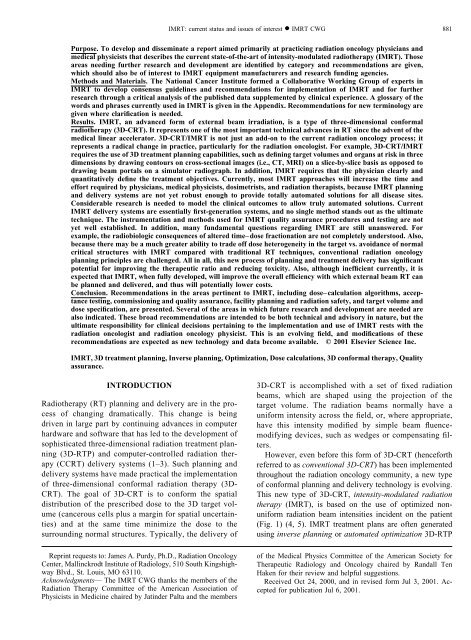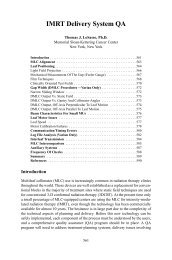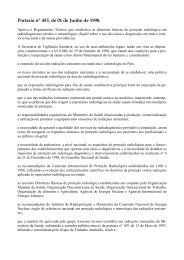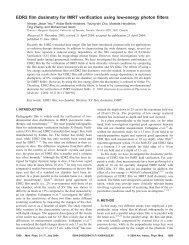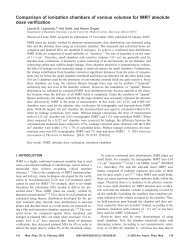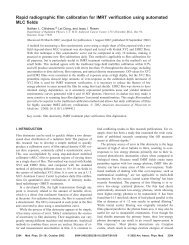intensity-modulated radiotherapy: current status and issues
intensity-modulated radiotherapy: current status and issues
intensity-modulated radiotherapy: current status and issues
You also want an ePaper? Increase the reach of your titles
YUMPU automatically turns print PDFs into web optimized ePapers that Google loves.
IMRT: <strong>current</strong> <strong>status</strong> <strong>and</strong> <strong>issues</strong> of interest ● IMRT CWG<br />
881<br />
Purpose. To develop <strong>and</strong> disseminate a report aimed primarily at practicing radiation oncology physicians <strong>and</strong><br />
medical physicists that describes the <strong>current</strong> state-of-the-art of <strong>intensity</strong>-<strong>modulated</strong> <strong>radiotherapy</strong> (IMRT). Those<br />
areas needing further research <strong>and</strong> development are identified by category <strong>and</strong> recommendations are given,<br />
which should also be of interest to IMRT equipment manufacturers <strong>and</strong> research funding agencies.<br />
Methods <strong>and</strong> Materials. The National Cancer Institute formed a Collaborative Working Group of experts in<br />
IMRT to develop consensus guidelines <strong>and</strong> recommendations for implementation of IMRT <strong>and</strong> for further<br />
research through a critical analysis of the published data supplemented by clinical experience. A glossary of the<br />
words <strong>and</strong> phrases <strong>current</strong>ly used in IMRT is given in the Appendix. Recommendations for new terminology are<br />
given where clarification is needed.<br />
Results. IMRT, an advanced form of external beam irradiation, is a type of three-dimensional conformal<br />
<strong>radiotherapy</strong> (3D-CRT). It represents one of the most important technical advances in RT since the advent of the<br />
medical linear accelerator. 3D-CRT/IMRT is not just an add-on to the <strong>current</strong> radiation oncology process; it<br />
represents a radical change in practice, particularly for the radiation oncologist. For example, 3D-CRT/IMRT<br />
requires the use of 3D treatment planning capabilities, such as defining target volumes <strong>and</strong> organs at risk in three<br />
dimensions by drawing contours on cross-sectional images (i.e., CT, MRI) on a slice-by-slice basis as opposed to<br />
drawing beam portals on a simulator radiograph. In addition, IMRT requires that the physician clearly <strong>and</strong><br />
quantitatively define the treatment objectives. Currently, most IMRT approaches will increase the time <strong>and</strong><br />
effort required by physicians, medical physicists, dosimetrists, <strong>and</strong> radiation therapists, because IMRT planning<br />
<strong>and</strong> delivery systems are not yet robust enough to provide totally automated solutions for all disease sites.<br />
Considerable research is needed to model the clinical outcomes to allow truly automated solutions. Current<br />
IMRT delivery systems are essentially first-generation systems, <strong>and</strong> no single method st<strong>and</strong>s out as the ultimate<br />
technique. The instrumentation <strong>and</strong> methods used for IMRT quality assurance procedures <strong>and</strong> testing are not<br />
yet well established. In addition, many fundamental questions regarding IMRT are still unanswered. For<br />
example, the radiobiologic consequences of altered time–dose fractionation are not completely understood. Also,<br />
because there may be a much greater ability to trade off dose heterogeneity in the target vs. avoidance of normal<br />
critical structures with IMRT compared with traditional RT techniques, conventional radiation oncology<br />
planning principles are challenged. All in all, this new process of planning <strong>and</strong> treatment delivery has significant<br />
potential for improving the therapeutic ratio <strong>and</strong> reducing toxicity. Also, although inefficient <strong>current</strong>ly, it is<br />
expected that IMRT, when fully developed, will improve the overall efficiency with which external beam RT can<br />
be planned <strong>and</strong> delivered, <strong>and</strong> thus will potentially lower costs.<br />
Conclusion. Recommendations in the areas pertinent to IMRT, including dose–calculation algorithms, acceptance<br />
testing, commissioning <strong>and</strong> quality assurance, facility planning <strong>and</strong> radiation safety, <strong>and</strong> target volume <strong>and</strong><br />
dose specification, are presented. Several of the areas in which future research <strong>and</strong> development are needed are<br />
also indicated. These broad recommendations are intended to be both technical <strong>and</strong> advisory in nature, but the<br />
ultimate responsibility for clinical decisions pertaining to the implementation <strong>and</strong> use of IMRT rests with the<br />
radiation oncologist <strong>and</strong> radiation oncology physicist. This is an evolving field, <strong>and</strong> modifications of these<br />
recommendations are expected as new technology <strong>and</strong> data become available. © 2001 Elsevier Science Inc.<br />
IMRT, 3D treatment planning, Inverse planning, Optimization, Dose calculations, 3D conformal therapy, Quality<br />
assurance.<br />
INTRODUCTION<br />
Radiotherapy (RT) planning <strong>and</strong> delivery are in the process<br />
of changing dramatically. This change is being<br />
driven in large part by continuing advances in computer<br />
hardware <strong>and</strong> software that has led to the development of<br />
sophisticated three-dimensional radiation treatment planning<br />
(3D-RTP) <strong>and</strong> computer-controlled radiation therapy<br />
(CCRT) delivery systems (1–3). Such planning <strong>and</strong><br />
delivery systems have made practical the implementation<br />
of three-dimensional conformal radiation therapy (3D-<br />
CRT). The goal of 3D-CRT is to conform the spatial<br />
distribution of the prescribed dose to the 3D target volume<br />
(cancerous cells plus a margin for spatial uncertainties)<br />
<strong>and</strong> at the same time minimize the dose to the<br />
surrounding normal structures. Typically, the delivery of<br />
Reprint requests to: James A. Purdy, Ph.D., Radiation Oncology<br />
Center, Mallinckrodt Institute of Radiology, 510 South Kingshighway<br />
Blvd., St. Louis, MO 63110.<br />
Acknowledgments— The IMRT CWG thanks the members of the<br />
Radiation Therapy Committee of the American Association of<br />
Physicists in Medicine chaired by Jatinder Palta <strong>and</strong> the members<br />
3D-CRT is accomplished with a set of fixed radiation<br />
beams, which are shaped using the projection of the<br />
target volume. The radiation beams normally have a<br />
uniform <strong>intensity</strong> across the field, or, where appropriate,<br />
have this <strong>intensity</strong> modified by simple beam fluencemodifying<br />
devices, such as wedges or compensating filters.<br />
However, even before this form of 3D-CRT (henceforth<br />
referred to as conventional 3D-CRT) has been implemented<br />
throughout the radiation oncology community, a new type<br />
of conformal planning <strong>and</strong> delivery technology is evolving.<br />
This new type of 3D-CRT, <strong>intensity</strong>-<strong>modulated</strong> radiation<br />
therapy (IMRT), is based on the use of optimized nonuniform<br />
radiation beam intensities incident on the patient<br />
(Fig. 1) (4, 5). IMRT treatment plans are often generated<br />
using inverse planning or automated optimization 3D-RTP<br />
of the Medical Physics Committee of the American Society for<br />
Therapeutic Radiology <strong>and</strong> Oncology chaired by R<strong>and</strong>all Ten<br />
Haken for their review <strong>and</strong> helpful suggestions.<br />
Received Oct 24, 2000, <strong>and</strong> in revised form Jul 3, 2001. Accepted<br />
for publication Jul 6, 2001.


